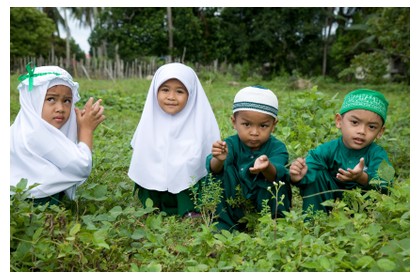- Basic phrases to learn
- Meeting the locals
- Eating
- Dress code
- Attractions
- Other customs
- Orang Asli
- Dayak People
- Kadazan People

| ||||||||||||
|
Malaysia Culture
"You don't have to burn books to destroy culture.
|
||||||||||||

|
The Malaysia culture is a mix of many different cultures!
The main cultures are the ancient Malay culture, the Chinese and the Indian culture.
And it doesn't stop there...
These three groups are joined by countless tribes, many of them living in the jungle and the coastal areas of Borneo.
Despite the fact that these groups have maintained their own cultural identity, their cultures have been mixed through intermarriage.
In our case, we're talking about Chinese marrying Malay, or Malay marrying Indian etc.
5 interesting things to know about the Malaysia culture:
- Malay are the largest ethnic group of people in Malaysia!
- Even though Malaysia is a Muslim country, it's less "extreme" than parts of the Middle East.
- Indians have been visiting Malaysia for 2000 years, but they didn't settle in Malaysia until
the 19th century. Many of them came from South India because they were fleeing from a poor economy.
- Most of the tribes people in Malaysia share a strong spiritual bond to the rainforest.
- The official religion in Malaysia is Islam, but there are many other religions in Malaysia's melting pot. Just to mention a couple, you have Buddhism, Hinduism, animism, Christianity, Confucianism etc.
To get the most of the Malaysia culture, here are some useful basic Bahasa Malay phrases:
Greeting: "Selamat"
Yes: "Ya"
No: "Tidak"
Thank you: "Terima kasih"
Sorry: "Maaf"
What's your name?: "Apa nama awak?"
My name is ...... : "Nama saya "
Here come the tips!
Meeting Malaysians -
How to do it in Malaysian Culture
But sometimes, they're just too friendly and have an idea that they should save you the frustration, instead of telling the truth.
In Semporna, we were sent to the doctor before we could start the diving course. When we arrived there, the place was full of locals waiting for their turn, while I needed the medical check right away.
So, I asked the nice ladies by the counter if there were any chances of getting an appointment that day. Her answer was:
"Yes"
I was glad when she said yes! But I was kind of confused, and thought: "Then why are all these people still waiting?"
Me: "Ok, when can I have an appointment?"
The lady: "Soon."
I thanked her, and we sat down to wait. After 1 hour, I got a little impatient. I asked the same lady again, and this time she said:
"No, no, we're full..."
... See my point ?
before entering Malay's home. Shoes are dirty. I don't need to explain that.
In Malaysia culture, the traditional greeting of Salam resembles a handshake with both of your hands, but without the grasp.
The man offers both hands, he lightly touches his friend's outstretched hands, and then brings his hands to his chest. The visitor should reciprocate the Salam.
If you're a man, never offer to shake the hands of Muslim ladies. They have to initiate the handshake. Or otherwise they will just nod or smile politely. Muslim ladies can of course handshake with other women.
When you meet Chinese locals, both men and women can shake hands. But women have to initiate by reaching out her hand first.
Indians hand shake with their family members. But when it comes to handshaking with the opposite sex, smiling and nodding is considered as sufficient.
Even though you're left-handed, never use your left hand to shake hands with a Malay Muslim. The left hand is considered as dirty.
But don't give them alcohol or anything made of pigskin. If you give food, it has to be halal. Offer gifts with your right hand, or if it's a large gift, use both of your hands.
In general, whether you're visiting a Malay, Chinese or Indian, avoid wrapping the gift in white, black, and blue paper because this is associated with, among other things, death.
You can wrap the gift in yellow if you're giving the gift to a Chinese, but not to Malay. To Malays, yellow is the color of the royal family.
Malays get easily embarrassed and uncomfortable. Try to remain calm.
Return to top of Malaysia Culture
Eating with Malaysians
- How to do it in Culture of Malaysia

|
One of the important parts of Malaysia culture, is that most of the food served is halal.
Halal refers to what food the Muslim can eat and can't eat according the Sharia Law. And it also means that the meat is cut in a proper way of slaughtering an animal, called Dhabiha.
I even saw that some potato chips were halal, and in some McDonalds you won't find ordinary French fries, but potato cakes!
Another thing about the Islamic culture which you should know about is the Ramadan.
Ramadan has personally fascinated and shocked me because it means that most Muslims all over the world don't eat and drink between dawn and sunset, in one of the holy months in the Islamic calendar.
The Ramadan is not meant to harm the Muslims in any way, but to teach them patience and modesty.
- Eat with your right hand if you're not using fork and spoon. Do this even if you're left-handed.
Like in the Philippines (which is the same in Malaysia), place a small enough amount of food between your four fingers and the thumb. Then shove the food in your mouth with your thumb. The trick is to not get food on the palm of your hand.
If you're unsure, observe the locals.
If you're using spoon and fork, hold the spoon with your right hand and the fork with your left hand.
Malaysia Culture: Halal Logo -
image credit: eastasiafair.comWhen eating at Chinese restaurants, you'll usually get chopsticks, spoon and fork. Use the chopsticks for eating the bowl of noodles, and the spoon to drink the soup.
If you're not comfortable with chopsticks, you can use the fork and spoon!
- Tipping is not expected because 5-10% government tax is automatically added.
To be on the safe side, check if the menu or the receipt says anything about a tax. If not, you should tip them with 5-10% extra (of the total amount).
- When you're eating at food stalls, you usually pay when the food is brought over.
Dress Code in
Malaysian Culture?

image credit: flickr.com |
- Malays share the same attitude with Southeast Asia when it comes to dress codes
As long as you're not on the beach, don't wear clothing that will show off your stomach, bare shoulders and cleavage.
Wearing hot pants or miniskirt should be avoided. This type of dress code applies especially in the province of Kelantan, which is mainly inhabited by conservative Muslims and strongly influenced by local customs and traditions.
- When visiting mosques, wear long clothing
If you don't wear long clothing, you can otherwise borrow.
For example: At the National Mosque in Kuala Lumpur, they lend out purple robes at the entrance, looking like the elves from Lord of the Rings.
Visiting attractions
in Malaysia
- If you're visiting a mosque, or another sacred or important place,
don't touch anything.
That includes statues, paintings, sculptures etc.
Other customs in
culture of Malaysia

|
- Prayers
Prayers are part of the Muslim way of life and you shouldn't be surprised when you hear it on the streets.
Daily prayers are a common must-do for the Muslims, and the Friday prayers are considered as the most important prayer of the week.
In Kuala Besut and Semporna, we woke up in the middle of the night (more like between 4-6 am in the morning) by the morning prayers which were chanted through a loud speaker on the streets.
- Here's a unusual thing about the Malaysia culture --
Never use your finger to point to objects, persons or places. Use your thumb. Picture the OK-sign (with your thumb up), then just point the thumb in the direction you want.
Tribes people
in Malaysia
There are many tribes in Malaysia and each of them has their own culture and customs, religion and language. All of them are part of the Malaysia culture.
Orang Asli

|
The population of Orang Asli is not just one type of people. The Orang Asli can be divided into three groups. Within each group you have different subgroups.
For example you have the Orang Laut and Meh Meri who live in the coastal areas and live off as fisher men (also called sea aborigines), while the Semai people are busy with agriculture ad have their own farms, like coco farms.
Based on this, each Orang Asli group has also its own culture, language and religion.
Did you know that...

|
- When walking into an Orang Asli village, it's usually safe? But smile a lot, because they can be skeptic to foreigners.
... But once you're accepted, you will feel very welcomed!
- When you're going sightseeing or looking for a place to stay for the night in an Orang Asli village:
Before visiting the rest of the village, seek the chief of the village (called Tok Batin) and introduce yourself.
- During the 18th and 19th century the Malays used Orang Asli people as slaves? They were considered as inhuman and savages.
- Orang Asli are animists, which means that they believe in the spiritual presence in objects.
- Orang Asli is one of the few aborigines in the world who don't practice the animal killing rituals.
They don't wear animal skins and they only hunt so they can actually have something as their livelihood.
- The people of Orang Asli were considered as war people (Senoi Praaq).
When the communism was threatening Malaysia in the 1950's, a special force of Orang Asli trained British soldiers in tracking skills and jungle survival!
Dayak people in Sarawak (Western part of Borneo)

image credit: indonesia-spots.blogspot.com |
Each ethnic group has its own and unique practice of their common religion, Kaharingan -- a form of animism.
Did you know that...
- The Dayak Iban people have their own traditional dance (ngajat), traditional music, festivals and so on?
- The men and women possess equal rights in status and property ownership?
- The Dayak Iban people are known for living in longhouses which can be 100s of meters long?
- Headhunting was an important part of Dayak culture? During wars, they captured the enemy's heads! Sounds brutal to me
Kadazan people in Sabah
(Eastern part of Borneo)
Did you know that...

|
- They have a rice spirit, called Bambazoon?
- The people of Kadazan are known to be "rice worshippers"?
They believe that the rice in any form embodies Bambazoon that must be protected from danger and harm.
- Their religion was animism? But now they're mainly Christians, mostly Catholics and some Protestants.
- The Kadazan food is influenced by Chinese cuisine?
- The most important festival for the Kadazan is the harvest festival (in May)?
Here they honor the spirit of the rice paddy after a year's harvest.
- They have another popular event which is the pageant "shows"? They crown the harvest queen
(called unduk ngadau) after several Kadazandusun girls have competed.
The point with this pageant contest is to commemorate the Huminodon spirit which is a mythological character of beauty.
Look for Malaysia Culture Shock! (book) through Amazon.com or other books on Malay culture. Malaysia Culture Shock! is full of good information on Malay culture!
Return to top of Malaysia Culture
Search this site
Books on Malaysia
Learn Malay
Traveling in Malaysia? Learn Malay for free!
 Learn Malaysian on your iPod
Learn Malaysian on your iPod
Connect with
Backpacking Tips Asia



